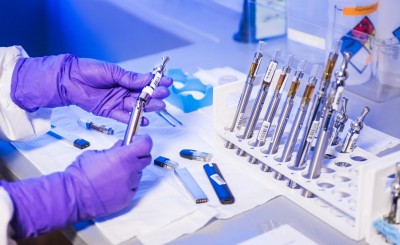Tech
Virtual Nanotitanium Project Enables Superior Material for Next-Gen Medical Implants
Mark Hoffman
First Posted: Aug 28, 2013 06:16 PM EDT
First Posted: Aug 28, 2013 06:16 PM EDT
With the ageing of European population, more and more people find themselves in need of dental or bone implants, which should help them to continue normal life even after mechanical damage or medical operations.
The implants should remain functional over dozens of years without any deformation, and also without producing any toxic substances in the body. Titanium is a rather strong material, with high biocompatibility, and is therefore one of the most promising materials for medical implants in trauma surgery, orthopedic and oral medicine.
However, dental and bone implant are subject to the very high loads. That is why even higher strength and damage resistances that those of common titanium are required to ensure the necessary service properties.
A very promising way to improve the implant materials and to ensure the required properties lies in nanotechnology. Applying the severe plastic deformation to metals, one can obtain new materials with very small grains (so-called ultrafine grained metals), which have also superior properties. These nanostructured materials are stronger and also more durable than common metals, and thus, they can serve best as materials for implant applications.
In order to develop nanostructured materials for medical implants, which correspond exactly to the service requirements, scientists and developers widely use computational models.
To develop the models and software for computational development of materials for implants, several group of European and Russian scientists joined their efforts in two coordinated projects, funded by European Commission (Framework 7 Program) and Russian Ministry of Education and Science. The research project "Virtual Nanotitanium", coordinated by the Technical University of Denmark, is covering different aspects of the development and computational modeling of nanomaterials since 2011.
- A software complex for multiscale virtual testing of nanotitanium for the strength, usability in biomaterials and lack of toxic materials has been developed. This software can be then used by companies developing the new implants and materials, to optimize the materials and technologies.
- A novel processing route for fabrication of nano-titanium, based on high temperature ECAP-C (equal-channel angular pressing) processing and drawing, was developed by Russian partner, Ufa State Aviation Technical University.
- A further practical result is the development, fabrication and testing of new nanotitanium based implants with lower diameter, which can withstand loads similar to those carried by implants of conventional design with a 50% larger diameter made from coarse-grained Ti. The implant is made from pure Ti, and doesn't contain any toxic alloying elements or allergens. The prototype was developed by the Czech project partner, small company Timplant.
In the framework of the project, a special issue of the international journal "Computational Materials Science" was published, and an International Conference on Computational Modelling of Nanostructured Materials is organized in Frankfurt am Main, Germany.
Dr. Leon Mishnaevsky Jr, Senior Researcher at Technical University of Denmark and Coordinator of the EU project,. noted that the application of developed computational models would allow efficient, reliable and quick development of nanomaterials for medical implants, thus, minimizing the necessity in animal tests. Further, the developed tools and technologies will open new possibilities in trauma surgery, orthopedic and oral medicine, allowing to heal bone illnesses, dental problems, and traumas at a new level. -- Technical University of Denmark
See Now: NASA's Juno Spacecraft's Rendezvous With Jupiter's Mammoth Cyclone



